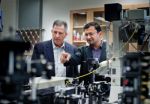(Press-News.org) CLEVELAND – 3D Mammography finds significantly more invasive cancers and reduces unnecessary recalls, according to a large, retrospective study published in June 25 issue of the Journal of the American Medical Association (JAMA). The study features data from University Hospitals Case Medical Center Seidman Cancer Center.
The study, the largest of its kind, focused on the impact of 3D mammography at a diverse range of sites across the U.S, looking at nearly half a million mammograms at 13 sites.
Key Findings:
41% increase in invasive cancer detected with 3D mammography
15% decrease in unnecessary recalls for false alarms
A 29% increase in the detection of all breast cancers
"This study confirms what we already know: 3D mammography finds more of the invasive, harmful cancers we want found and saves women the anxiety and cost of having additional exams for what turns out to be a false alarm," said the study's co-author Donna Plecha, MD, Director of Breast Imaging at UH Case Medical Center. "We already knew that breast screening saves lives and this study provides us with firm data that 3D mammography is a better test for detecting breast cancer early when it is treatable."
Hologic 3D mammography (breast tomosynthesis) was used exclusively in the study, as they are the only FDA-approved 3D mammography manufacturer. University Hospitals Case Medical Center was involved in the initial research on tomosynthesis and has offered 3D mammography since 2011.
The system combines advanced digital mammography and tomosynthesis-generated images to provide a more detailed, highly focused picture of the breast. These images are then used to produce a series of one-millimeter thick slices that can be viewed as a 3D reconstruction of the breast. Women see little difference between a conventional 2D mammogram and a 3D mammogram. The exam takes just a few seconds longer and the positioning is the same. The real difference is in the information available to the doctor.
The technology gives radiologists the ability to identify and characterize individual breast structures and clearly see features which might be obscured in a traditional 2D mammogram by overlapping normal breast anatomy that may mimic or mask a tumor. Dense tissue and overlapping tissue structures may lead to false positive or false negative results with standard mammography.
Breast cancer is a significant health problem and statistics indicate that one in eight women will develop the disease in her lifetime. The stage at which the cancer is discovered influences a woman's chance of survival and annual mammography after the age of 40 enables physicians to identify the smallest abnormalities. In fact, when breast cancer is detected early and confined to the breast, the five-year survival rate is 97 percent.
"Breast cancers caught in the initial stages by mammography are more likely to be cured and are less likely to require chemotherapy or as extensive surgery," said Dr. Plecha, who is also Assistant Professor at Case Western Reserve University School of Medicine. "This study shows that 3D mammography is a more effective screening tool, and we must make it accessible to all women."
INFORMATION:
The study, led by Dr. Sarah Friedewald at Advocate Lutheran Hospital in Park Ridge, Il, was published in advance of print on the JAMA website: http://jama.jamanetwork.com/journal.aspx
.
About University Hospitals
University Hospitals, the second largest employer in Northeast Ohio with 25,000 employees, serves the needs of patients through an integrated network of 12 hospitals, 26 outpatient centers and primary care physician offices in 16 counties. At the core of our $3.5 billion health system is University Hospitals Case Medical Center, one of only 18 hospitals in the country to have been named to U.S. News & World Report's most exclusive rankings list: the Best Hospitals 2013-14 Honor Roll. The primary affiliate of Case Western Reserve University School of Medicine, UH Case Medical Center is home to some of the most prestigious clinical and research centers of excellence in the nation, including cancer, pediatrics, women's health, orthopaedics, radiology, neuroscience, cardiology and cardiovascular surgery, digestive health, transplantation and genetics. Its main campus includes UH Rainbow Babies & Children's Hospital, ranked among the top children's hospitals in the nation; UH MacDonald Women's Hospital, Ohio's only hospital for women; and UH Seidman Cancer Center, part of the NCI-designated Case Comprehensive Cancer Center at Case Western Reserve University. For more information, go to http://www.uhhospitals.org
3D Mammography finds more invasive cancers and reduces unnecessary recalls
Donna Plecha, M.D., of University Hospitals Case Medical Center co-authored largest 3D study to date of nearly half a million women, published in JAMA
2014-06-24
ELSE PRESS RELEASES FROM THIS DATE:
Chronic migraine has a substantial impact on marriage and parenting
2014-06-24
A web-based study of 994 men and women with chronic migraine found that the condition significantly impacts family relationships and activities, including cancelled vacation plans and reduced quality time with partners and children. Feelings of guilt, anger and annoyance toward family members due to headache, and avoidance of sexual intimacy due to headache also were reported. Chronic migraine is generally defined as migraine with headaches occurring 15 or more days per month.
The Family Burden of Chronic Migraine to the Migraineur: Results of the CaMEO (Chronic Migraine ...
Demonstrating a driverless future
2014-06-24
In the coming decades, we will likely commute to work and explore the countryside in autonomous, or driverless, cars capable of communicating with the roads they are traveling on. A convergence of technological innovations in embedded sensors, computer vision, artificial intelligence, control and automation, and computer processing power is making this feat a reality.
This week, researchers from Carnegie Mellon University (CMU) will mark a significant milestone, demonstrating one of the most advanced autonomous vehicles ever designed, capable of navigating on urban roads ...
Can coral save our oceans?
2014-06-24
Coral reefs are home to a rich and diverse ecosystem, providing a habitat for a wide range of marine animals. But the increasing acidification of ocean water is jeopardizing the calcified foundations of these reefs, endangering the survival of thousands upon thousands of resident species.
New research by Prof. Yehuda Benayahu, Dr. Zehava Barkay, Prof. Maoz Fine, and their jointly supervised graduate student Yasmin Gabay of Tel Aviv University's Department of Zoology, Wolfson Applied Materials Research Center and the Interuniversity Institute for Marine Sciences in Eilat ...
UT Arlington nanoparticles could provide easier route for cell therapy
2014-06-24
UT Arlington physics researchers may have developed a way to use laser technology to deliver drug and gene therapy at the cellular level without damaging surrounding tissue. The method eventually could help patients suffering from genetic conditions, cancers and neurological diseases.
In a study published recently by the journal Nature Scientific Reports, the team paired crystalline magnetic carbon nanoparticles and continuous wave near-infrared laser beams for in what is called photothermal delivery. Authors of the new paper are Ali Koymen, a professor of physics; Samarendra ...
How to protect an American wildlife legacy
2014-06-24
A new paper shows that while science plays a critical role in informing conservation action, scientists must move beyond the realm of their expertise into less familiar areas like public relations, education, and even politics, to ultimately meet America's conservation goals.
The paper, "Moving Beyond Science to Protect a Mammalian Migration Corridor," appears in the current online edition on the journal Conservation Biology, and will appear in Volume 28 of the print edition. Authors are Joel Berger of the Wildlife Conservation Society (WCS) and the University of Montana, ...
Group recommends removing sexual orientation-related disorders from the ICD
2014-06-24
A working group evaluating sexual orientation-related disorders listed in the International Classification of Diseases (ICD), a publication of the World Health Organization (WHO), has recommended the disorders be deleted, a move that will make getting health care easier for gays and others who may have gender atypicality.
The WHO is the world body charged with deciding what is a disease and more than 170 countries, including the United States, follow their recommendations. The organization is currently revising the 10th edition of the ICD for release of the 11th edition ...
UMMS scientists show that monarch butterflies employ a magnetic compass during migration
2014-06-24
WORCESTER, MA – Each fall millions of monarch butterflies use a sophisticated navigation system to transverse 2,000 miles from breeding sites across the eastern United States to an overwintering habitat in specific groves of fir trees in central Mexico. Scientists at the University of Massachusetts Medical School and Worcester Polytechnic Institute have identified a new component of this complex system. They reported in Nature Communications that monarchs use a light-dependent, inclination magnetic compass to help them orient southward during migration.
"Taken as a whole, ...
Cancer risks increase with complex heart tests
2014-06-24
Complex heart imaging can increase cancer risks for children throughout their lifetime, according to a new study co-authored by Le Bonheur Cardiologist Jason Johnson, MD, MHS. The study, which appears in the June 9, 2014 issue of the American Heart Association's journal Circulation, is the first in which researchers quantified cumulative radiation doses in pediatric heart patients and predicted lifetime cancer risks based on the types of exposures.
In the study, Johnson and fellow researchers found that radiation from standard X-rays don't significantly raise cancer risks ...
Those with episodic amnesia are not 'stuck in time,' says philosopher Carl Craver
2014-06-24
In 1981, a motorcycle accident left Toronto native Kent Cochrane with severe brain damage and dramatically impaired episodic memory. Following the accident, Cochrane could no longer remember events from his past. Nor could he predict specific events that might happen in the future.
When neuroscientist Endel Tulving, PhD, asked him to describe what he would do tomorrow, Cochrane could not answer and described his state of mind as "blank."
Psychologists and neuroscientists came to know Cochrane, who passed away earlier this year, simply as "KC." Many scientists have described ...
Mining mountains of data for medical insights
2014-06-24
Epidemiologists know that an important piece of evidence is often staring you in the face – but it's not always easy to see the forest for the trees.
Danish scientists recently teamed up with University of New Mexico researchers to test a powerful new method for predicting the progress of common diseases through time by teasing out previously undetected patterns from a very large data set – in this case, the health records of Denmark's entire population.
This approach maps out surprising correlations: a disease like gout – a form of arthritis – is strongly linked to ...
LAST 30 PRESS RELEASES:
Making lighter work of calculating fluid and heat flow
Normalizing blood sugar can halve heart attack risk
Lowering blood sugar cuts heart attack risk in people with prediabetes
Study links genetic variants to risk of blinding eye disease in premature infants
Non-opioid ‘pain sponge’ therapy halts cartilage degeneration and relieves chronic pain
AI can pick up cultural values by mimicking how kids learn
China’s ecological redlines offer fast track to 30 x 30 global conservation goal
Invisible indoor threats: emerging household contaminants and their growing risks to human health
Adding antibody treatment to chemo boosts outcomes for children with rare cancer
Germline pathogenic variants among women without a history of breast cancer
Tanning beds triple melanoma risk, potentially causing broad DNA damage
Unique bond identified as key to viral infection speed
Indoor tanning makes youthful skin much older on a genetic level
Mouse model sheds new light on the causes and potential solutions to human GI problems linked to muscular dystrophy
The Journal of Nuclear Medicine ahead-of-print tip sheet: December 12, 2025
Smarter tools for peering into the microscopic world
Applications open for funding to conduct research in the Kinsey Institute archives
Global measure underestimates the severity of food insecurity
Child survivors of critical illness are missing out on timely follow up care
Risk-based vs annual breast cancer screening / the WISDOM randomized clinical trial
University of Toronto launches Electric Vehicle Innovation Ontario to accelerate advanced EV technologies and build Canada’s innovation advantage
Early relapse predicts poor outcomes in aggressive blood cancer
American College of Lifestyle Medicine applauds two CMS models aligned with lifestyle medicine practice and reimbursement
Clinical trial finds cannabis use not a barrier to quitting nicotine vaping
Supplemental nutrition assistance program policies and food insecurity
Switching immune cells to “night mode” could limit damage after a heart attack, study suggests
URI-based Global RIghts Project report spotlights continued troubling trends in worldwide inhumane treatment
Neutrophils are less aggressive at night, explaining why nighttime heart attacks cause less damage than daytime events
Menopausal hormone therapy may not pose breast cancer risk for women with BRCA mutations
Mobile health tool may improve quality of life for adolescent and young adult breast cancer survivors
[Press-News.org] 3D Mammography finds more invasive cancers and reduces unnecessary recallsDonna Plecha, M.D., of University Hospitals Case Medical Center co-authored largest 3D study to date of nearly half a million women, published in JAMA



